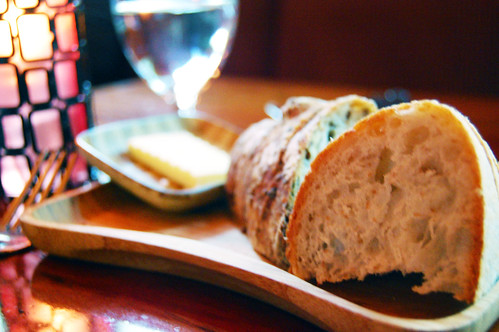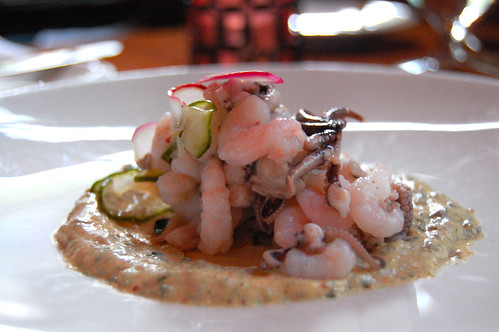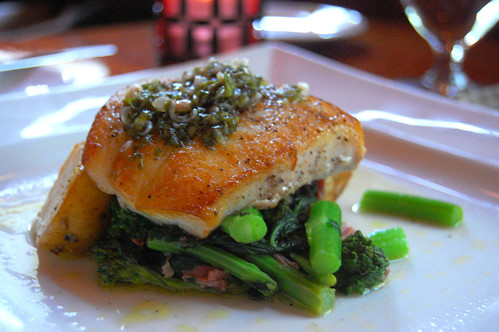
Pull-apart bread seems to be the rage these days, and this is my third attempt at one, though I think it's the first one I've posted about. I've also made cinnamon-sugar and cheese pull-apart bread, both of which were delish... but only after I picked off the top burned bits. The problem I had with all three pull-apart breads -- and this is probably particular to my oven -- is that the tops tended to brown very quickly, which meant that by the end of the required cooking time, the tops were way overdone. Because I'd had the experience with the first two breads, I managed to (mostly) avoid that fate for this lemon one. Still, do check on your bread about halfway through, in case you have an oven like mine. If it already looks nice and golden brown, cover it with foil and let it finish baking.

So as I mentioned above, you have to cut squares of dough and stack them in your bread pan, which is what makes the bread "pull apart." It's not difficult to do; it just takes a little bit of extra time.

The dough is a fairly sticky dough. As long as you keep your board and hands floured, it should be fine; I did add a bit more flour to the dough itself but kept it pretty sticky. Also, I used all lemon zest rather than lemon and orange. (As you can see from this photo, I still checked on the bread a little too late and the ends came out a lot darker than I might have wanted.)

What I wasn't too crazy about though? The cream cheese glaze. It gave the whole thing a nicer, more finished look, but flavor wise didn't add much. Next time I'll either find a different cream cheese glaze recipe to try or just leave it out altogether.
Finally, the recipe source calls this "lemon-scented pull-apart coffee cake." I'm not sure why. It's definitely not a cake. I've opted to call it by a less confusing and more accurate name!
Lemon-Scented Pull-Apart Bread (adapted from Flo Braker)
Ingredients
For the sweet yeast dough
- About 2 3/4 cups all-purpose flour
- 1/4 cup granulated sugar
- 2 1/4 tsp (1 envelope) instant yeast
- 1/2 tsp salt
- 1/3 cup whole milk
- 2oz unsalted butter
- 1/4 cup water
- 1 1/2 tsp pure vanilla extract
- 2 large eggs, at room temperature
For the lemon paste pie filling
- 1/2 cup granulated sugar
- 3 tbsp finely grated lemon zest (3 lemons)
- 1 tbsp finely grated orange zest
- 2oz unsalted butter, melted
For the tangy cream cheese icing
- 3oz cream cheese, softened
- 1/3 cup powdered sugar
- 1 tbsp whole milk
- 1 tbsp fresh lemon juice
Method
Make the sweet yeast dough
- Stir together 2 cups of the flour, the sugar, yeast, and salt in the bowl of a stand mixer. In a small saucepan, heat the milk and butter over low heat just until the butter is melted. Remove from the heat, add the water, and set aside until warm (120 to 130°F), about 1 minute. Add the vanilla extract.
- Pour the milk mixture over the flour-yeast mixture. Using a rubber spatula, mix until the dry ingredients are evenly moistened. Attach the bowl to the mixer and fit the mixer with the paddle attachment. With the mixer on low speed, add the eggs, one at a time, mixing after each addition just until incorporated. Stop the mixer, add 1/2 cup of the remaining flour, and resume mixing on low speed until the dough is smooth, 30 to 45 seconds. Add 2 more tablespoons flour and mix on medium speed until the dough is smooth, soft, and slightly sticky, about 45 seconds.
- Sprinkle a work surface with 1 tbsp flour and center the dough on the flour. Knead gently until smooth and no longer sticky, about 1 minute, adding an additional 1 to 2 tbsp flour only if necessary to lessen the stickiness. Place the dough in a large bowl, cover the bowl securely with plastic wrap, and let the dough rise in a warm place (about 70°F) until doubled in size, 45 to 60 minutes. Press the dough gently with a fingertip. If the indentation remains, the dough is ready for the next step. While the dough is rising, make the filling.
- In a small bowl, mix together the sugar and the lemon and orange zests. Set the sandy-wet mixture nearby (the sugar draws out moisture from the zests to create the consistency).
- Center a rack in the oven and preheat the oven to 350°F. Lightly grease a 9x5x3-inch loaf pan.
- Gently deflate the dough. On a lightly floured work surface, roll out the dough into a 20-by-12-inch rectangle. Using a pastry brush, spread the melted butter generously over the dough. Cut the dough crosswise into 5 strips, each about 12 by 4 inches. Sprinkle 1 1/2 tbsp of the zest-sugar mixture over one of the buttered rectangles. Top with a second rectangle and sprinkle it with 1 1/2 tbsp of the zest-sugar mixture. Repeat with the remaining dough rectangles and zest-sugar mixture, ending with a stack of 5 rectangles. Work carefully when adding the crumbly zest filling, or it will fall off when you have to lift the stacked pastry later.
- Slice the stack crosswise through the 5 layers to create 6 equal strips, each about 4x2 inches. Fit these layered strips into the prepared loaf pan, cut edges up and side by side. (There should be plenty of space on either side of the 6 strips widthwise in the pan, while lengthwise it will be tight. When the dough rises it will fill in that space.) Loosely cover the pan with plastic wrap and let the dough rise in a warm place (70°F) until puffy and almost doubled in size, 30 to 50 minutes. Press the dough gently with a fingertip. If the indentation remains, the dough is ready for baking.
- Bake the coffee cake until the top is golden brown, 30 to 35 minutes. Transfer to a wire rack and let cool in the pan for 10 to 15 minutes.
- In a medium bowl, using a rubber spatula, vigorously mix the cream cheese and sugar until smooth. Beat in the milk and lemon juice until the mixture is creamy and smooth.
- To remove the coffee cake from the pan, tilt and rotate the pan while gently tapping it on a counter to release the cake sides. Invert onto a wire rack, then turn it so that it's right-side up.
- Slip a sheet of waxed paper under the rack to catch any drips from the icing. Using a pastry brush, coat the top of the warm cake with the icing to glaze it.















































